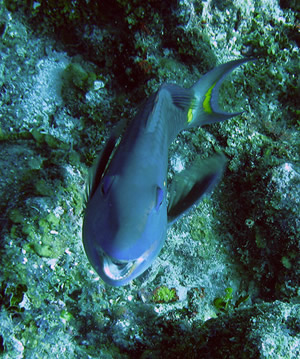Click on image for full size
Courtesy of Anne Pharamond
Reef Health Depends on Algae Chomping Fish
News story originally written on October 31, 2007
Can unhealthy coral reefs recover once they become unhealthy? According to a recent study, they may not be able to unless people take steps to make reefs healthier.
A healthy coral reef is full of life. Corals are the little animals that build much of the rocky parts of a reef. Large eels and rays, tiny snails and shrimp, and numerous fish all live there. Algae are a part of the reef ecosystem too. But when a reef is unhealthy, algae overgrow the reef, taking over areas where corals once lived. More and more reefs, especially in the Caribbean Sea, are becoming unhealthy and overgrown with algae.
Creatures that eat algae are very important in reefs. They keep algae from overgrowing. And the biggest algae eaters on Caribbean reefs today are parrotfish. Parrotfish have a hard plate in their mouth that allows them to bite at algae-covered rocks. They eat the algae along with a bit of rock too. All that munching makes a crunching sound underwater. However, fishing has reduced the number of parrotfish and this may make reefs less healthy.
A team of scientists wanted to know whether Caribbean reefs that are overgrown with algae could become healthy again. They made a computer model of a reef and tested what happened to it when factors, like the number of parrotfish, were changed. They discovered that without enough parrotfish munching algae from the reef, more of the reef becomes covered with algae and corals become less healthy. The scientists suggest that protecting parrotfish can help coral reefs to survive.















